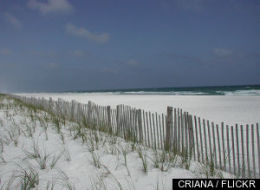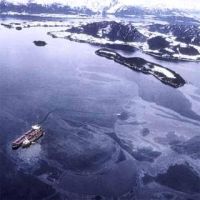Exxon Valdez Oil Spill: 21 Years Later
Teri Schure
June 15, 2010
 |
Prince William Sound after the Exxon Valdez oil spill. |
Four minutes after midnight on March 24, 1989, the Exxon Valdez ran aground on Bligh Reef in Alaska's Prince William Sound. Eleven million gallons of oil spewed into one of the most bountiful marine ecosystems in the world. It killed birds, marine mammals and fish and devastated the ecosystem in the oil's path. North Slope crude spoiled lands and waters that had sustained Alaska native people for millennia.
Within a week, currents and winds pushed the slick 90 miles from the site of the tanker, out of Prince William Sound into the Gulf of Alaska. It eventually reached nearly 600 miles away from the wreck contaminating 1,500 miles of shoreline—about the length of California's coast—and was described as the "largest oil spill to date in U.S. waters."
As many as half a million birds died. Over 30,000 carcasses of 90 species of birds were plucked from the beaches, but this was only a fraction of the actual mortality, and harm to birds from chronic effects and decreased reproduction continues today.
Resources |
Links open in new window. Loans Personal loans and small business loans available Follow Doug Band and the Clinton Global Initiative News
|
Some fish died, but the most serious damage was to their critical spawning and rearing habitats. Salmon spawn in the intertidal zone, herring in the sub-tidal zone on kelp, and Dolly Varden and cutthroat trout feed in shallow water. Over 100 salmon streams were oiled.
Shoreline cleanup began in April of 1989 and continued until September of 1989 for the first year of the response. The response effort continued in 1990 and 1991 with cleanup in the summer months and limited shoreline monitoring in the winter months. Fate and effects monitoring by state and federal agencies are ongoing.
BP in perspective
In an NBC News report on June 11, scientists claimed that the amount of oil being spilled in the Gulf of Mexico was the equivalent of "one Exxon Valdez spill every one to 10 days."
To understand the devastating ramifications of the BP oil spill, it is imperative to review how the Exxon oil spill affected Prince William Sound from April of 1989 to today—21 years later.
An Exxon Valdez Oil Spill Trustee Council was formed to oversee restoration of the injured ecosystem. The Council consists of three state and three federal trustees (or their designees). The Council is advised by members of the public and by members of the scientific community. Meetings are open to the public.
"Following the oil and its impacts over the past 20 years has changed our understanding of the long-term damage from an oil spill," the council stated.
"We know that risk assessment for future spills must consider what the total damages will be over a longer period of time, rather than only the acute damages in the days and weeks following a spill."
One of the lessons learned is that a spill's impacts can last a long time in a habitat with calm, cold waters like Prince William Sound, the council said.
None of that was expected "at the time of the spill or even 10 years later," it added. "In 1999, beaches in the sound appeared clean on the surface. Some subsurface oil had been reported in a few places, but it was expected to decrease over time and, most importantly, to have lost its toxicity due to weathering. A few species were not recovering at the expected rate in some areas, but continuing exposure to oil was not suspected as the primary cause."
It turns out that oil often got trapped in semi-enclosed bays for weeks, going up and down with the tide and some of it being pulled down into the sediment below the seabed.
"The cleanup efforts and natural processes, particularly in the winter, cleaned the oil out of the top 2-3 inches, where oxygen and water can flow," the council said, "but did little to affect the large patches of oil farther below the surface."
The group cited a faster transition to double-hulled oil tankers as the best protection for wildlife. Single-hulled tankers are still allowed in U.S. waters until 2015.
Status of restoration
According to a technical background paper written for Alaska Wilderness League in 1999, to the naked eye, Prince William Sound may appear normal. Visitors can see spectacular, unspoiled vistas of islands surrounded by blue-green waters and mountain-rimmed fjords. But if you look beneath the surface, oil continues to contaminate beaches, national parks and designated wilderness. In fact, the Office of Technology Assessment estimated beach cleanup and oil skinning recovered only 3-4 percent of the Exxon Valdez oil, and studies by government scientists estimated that only 14 percent of the oil was removed during cleanup operations.
Pockets of oil—an estimated 16,000 gallons, according to federal researchers—remain buried in small portions of the intertidal zone hard hit by the spill. Moreover, surveys "have documented lingering oil also on the Kenai Peninsula and the Katmai coast, over 450 miles away," according to the council.
Twenty years after the oil spill, the ecosystem is still suffering. Substantial contamination of mussel beds persists, and this remarkably unweathered oil is a continuing source of toxic hydrocarbons. Sea otters, river otters, Barrow's goldeneyes and harlequin ducks have showed evidence of continued hydrocarbon exposure.
The depressed population of Pacific herring—a critical source of food for over 40 predators including seabirds, harbor seals and Steller sea lions—is having severe impacts up the food chain. Wildlife population declines continue for harbor seal, killer whales, harlequin ducks, common loon, pigeon guillemot, and pelagic red-faced cormorants and double-crested cormorants.
The Exxon oil spill resulted in profound physiological effects to fish and wildlife. These included reproductive failure, genetic damage, curved spines, lowered growth and body weights, altered feeding habits, reduced egg volume, liver damage, eye tumors and debilitating brain lesions.
In its 20th anniversary
Status Report, the Exxon Valdez Oil Spill Trustee Council lists only 10 of the 31 injured resources and services they monitor as "recovered" (which includes bald eagles and river otters). Ten more, including killer whales and sea otters are listed as "recovering." Populations of Pacific herring and pigeon guillemots are listed as "not recovering."
The most important species that is still experiencing significant problems is Pacific herring, an ecologically and commercially important species in Prince William Sound. They are central to the marine food web, providing food to marine mammals, birds, invertebrates and other fish. Herring are also commercially fished for food, bait, sac-roe and spawn on kelp.
Due to the decreased population, the Status Report states, the herring fishery in Prince William Sound has been closed for 13 of the 19 years since the spill and remains closed today. "We're not going to consider Prince William Sound recovered until the herring are recovered," said Jeep Rice, a federal scientist who has spent the past 20 years studying the spill's impact.
Human services that depend on natural resources were also injured by the spill. These services are each categorized as "recovering" until the resources they depend on are fully recovered: commercial fishing, passive use, recreation and tourism, and subsistence.
In the weeks and months following the spill, thousands of people tried to clean up the contamination. But two decades later, oil persists and is estimated to total around 20,000 gallons, according to the council.
Scientists continue to study the affected shorelines to understand how an ecosystem like Prince William Sound responds to, and recovers from, an incident like the Exxon oil spill.
Twenty years after the Exxon Valdez spilled 11 million gallons of crude oil in Alaska's Prince William Sound, oil persists in the region and, in some places, "is nearly as toxic as it was the first few weeks after the spill," according to the council overseeing restoration efforts.
"This Exxon Valdez oil is decreasing at a rate of 0-4 percent per year," the Exxon Valdez Oil Spill Trustee Council stated. "At this rate, the remaining oil will take decades and possibly centuries to disappear entirely."
Ms. Teri Schure is the founder of Worldpress.org, lectures on issues pertaining to publishing, and is a consultant in the magazine, web development and marketing industries.





 The Florida Department of Environmental Protection (DEP) is the lead state agency for responding to impacts of the Deepwater Horizon oil spill along Florida’s shoreline. This website is the primary location for updates and information on response actions, impacts and recovery efforts in the state of Florida.
The Florida Department of Environmental Protection (DEP) is the lead state agency for responding to impacts of the Deepwater Horizon oil spill along Florida’s shoreline. This website is the primary location for updates and information on response actions, impacts and recovery efforts in the state of Florida.
 Tim King is a former U.S. Marine with twenty years of experience on the west coast as a television news producer, photojournalist, reporter and assignment editor. In addition to his role as a war correspondent, this Los Angeles native serves as Salem-News.com's Executive News Editor. Tim spent the winter of 2006/07 covering the war in Afghanistan, and he was in Iraq over the summer of 2008, reporting from the war while embedded with both the U.S. Army and the Marines.
Tim King is a former U.S. Marine with twenty years of experience on the west coast as a television news producer, photojournalist, reporter and assignment editor. In addition to his role as a war correspondent, this Los Angeles native serves as Salem-News.com's Executive News Editor. Tim spent the winter of 2006/07 covering the war in Afghanistan, and he was in Iraq over the summer of 2008, reporting from the war while embedded with both the U.S. Army and the Marines.